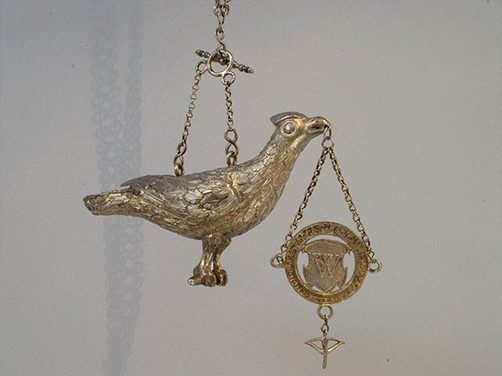International art fair, MUNICH HIGHLIGHTS
Dear Art lovers
As summer draws to a close, we look forward to the upcoming autumn, brought into a wonderful beginning alongside Munich’s international art fair, the MUNICH HIGHLIGHTS. Set in the heart of the city at the Residenz, MUNICH HIGHLIGHTS showcases the very best of the art market within Germany. As ever, we are full of anticipation and immensely proud to present our finest collection of silver pieces. Welcoming many new objects within the last few months, which sit beautifully alongside our existing collection, we’d like to take this opportunity to introduce some of our new masterpieces.
pair of entrée dishes with warming covers by odiot/biennais
In the splendor of the “epoque impériale”
Paris 1798 – 1809

The warming covers, made by Jean Baptiste Claude Odiot, stand on a smooth base decorated at both the top and bottom by a tongue frieze. The artfully designed knob closes as a round plate, which is decorated on the outside with a frieze of flowers and ribbons. In the middle there is a woman’s head framed with foliage and grapes, in addition there is an owner’s medallion at the bottom of the inside.
Inspired by the return of classical Greek and Egyptian motifs, Jean Baptiste Claude Odiot received court commissions from across Europe. In 1802 he was awarded a gold medal at the third Exposition de l’Industrie in Paris. He executed a travel service (around 1795–1809) for Napoleon and a large dinner service (1798–1809; Munich, Residence) for Maximilian I Joseph of Bavaria (1756–1825).
The two entrée dishes, decorated with a palmette frieze on the outer edge, were crafted by Martin-Guillaume Biennais, who is known to have been one of the most important Parisian gold and silversmiths, having been appointed royal goldsmith by Napoleon after his coronation.
You can find more information and pictures about the objects on our website.
coin lidded beaker by a passionate collector
cast corpus, elaborately crafted and of outstanding
quality, ca. 1.5kg
east prussia or riga around 1770

This conically shaped foot beaker, exceptional for its heavy quality, obviously presents the coin collection of a passionate collector. 23 valuable coins from the central European region, spanning more than two centuries and various ruling houses, cities and dioceses, were embedded into the cast cup by the technically skilled goldsmith in the most artistic manner.
An example of a coin is the Konstanz thaler with the inscription “DER STAT COSTANTZ MVINTZ 1538”, one of the first and only Konstanz minted coins that, due to the influence of the Reformation, has a coin inscription in German language.
East Prussia, especially in the 18th century, combined the stamping of year letters and masters’ marks throughout its silver craftsmanship, thereby suggesting the origin of this piece. On the other hand, the conical shape of the lidded beaker, crowned with a spherical knob and the floral decoration, rather suggests a Baltic origin of the piece, quite possibly Riga. As Annelore Leistikow writes, in Riga, especially in the second half of the 18th century, “the decoration as widely known in Prussia, with coins and medals on the wall of the beakers, was adopted”. Hereby this wonderfully coin lidded beaker is still somewhat shrouded in mystery, and we can highly recommend taking a closer look into our detailed description found on our website.
parrot trophy of the westenfeld riflemen’s guild
1598 silver, gilt

Crafted as an award at the “Kings shooting” of the farming community of Westenfeld, the parrot is rooted in history. As an award, for the sporting competitions that were already widespread in the 14th century, it had become fashionable from 1500 onwards to attach birds onto chains to honour the “bird-shooting king” after winning the competition several times. Honour chains like these, also known as royal chains, along with plaques, medals, and coins hanging from them, were given as awards to particularly talented shooters. The transfer of the trophy to the recognised art collection of Monsieur Maxime Ducamp in the 1880s, ensured that the object is in an excellent state of preservation. Its appreciation is also evidenced by its mention and illustration in an encyclopedia of the 19th century.
Inscription in the centre of the shield: monogram “BW”, with a ring around and the inscription: “DE(R?) BURSCHAP. THO. WEST. VELDE. THON. ALDENBERGEI HORT DUSSE BIRD THO 1598“
With these new masterpieces, we look forward to presenting our collection at the MUNICH HIGHLIGHTS in the Residenz from the 18th to 22nd of October 2023.
If you desire any further detailed information on our pieces, please feel free to contact us. Alternatively, take look at our webpage: www.helga-matzke.com/ or our social media channels, Instagram and Facebook, which give a closer, regularly updated insight into further wonderful pieces of our collection.
Team Helga Matzke


